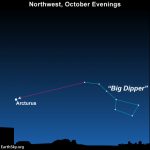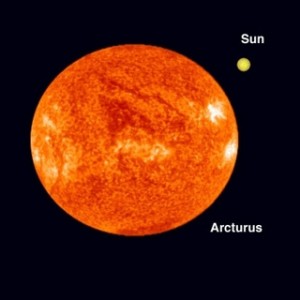
Tonight, look for Arcturus, one of three stars noticeable for flashing in colors in the evening sky at this time of year. You should be able to see it in the west at dusk or nightfall. Once it gets good and dark, and you live at mid-to-far latitudes in the Northern Hemisphere, you can verify that this star is Arcturus by using the Big Dipper asterism.
The arc of the Big Dipper handle extended outward always points to Arcturus.
Notice that Arcturus is an orange-colored star.
Every year at this time, we get questions about three different stars that are flashing different colors. One is Arcturus in the constellation Boötes the Herdsman, shining in the west to northwest after sunset. Another is Capella in the constellation Auriga the Charioteer, which is now in the northeast in mid-evening. And the third is Sirius in the constellation Canis Major the Greater Dog, which is now in the south before dawn.
All three appear to be flashing colors for the same reason … all three of these stars are bright and, at this time of year, noticeably low in the sky as seen from Northern Hemisphere locations. When you see an object low in the sky, you’re seeing it through a greater thickness of atmosphere than when it’s overhead. The atmosphere refracts or splits the stars’ light to cause these stars to flash in the colors of the rainbow.
At mid-northern latitudes, scintillating Arcturus adorns the western evening sky all through October.

If they were located at the same distance from us, you’d see that Arcturus is a much, much larger star than our sun. Image via Windows to the Universe
Bottom line: On October evenings, look for the brilliant star Arcturus in the western sky, flashing in colors. You can be sure you’ve identified this yellow-orange star if the handle of the Big Dipper points to it.
from EarthSky https://ift.tt/2ATi87t

Tonight, look for Arcturus, one of three stars noticeable for flashing in colors in the evening sky at this time of year. You should be able to see it in the west at dusk or nightfall. Once it gets good and dark, and you live at mid-to-far latitudes in the Northern Hemisphere, you can verify that this star is Arcturus by using the Big Dipper asterism.
The arc of the Big Dipper handle extended outward always points to Arcturus.
Notice that Arcturus is an orange-colored star.
Every year at this time, we get questions about three different stars that are flashing different colors. One is Arcturus in the constellation Boötes the Herdsman, shining in the west to northwest after sunset. Another is Capella in the constellation Auriga the Charioteer, which is now in the northeast in mid-evening. And the third is Sirius in the constellation Canis Major the Greater Dog, which is now in the south before dawn.
All three appear to be flashing colors for the same reason … all three of these stars are bright and, at this time of year, noticeably low in the sky as seen from Northern Hemisphere locations. When you see an object low in the sky, you’re seeing it through a greater thickness of atmosphere than when it’s overhead. The atmosphere refracts or splits the stars’ light to cause these stars to flash in the colors of the rainbow.
At mid-northern latitudes, scintillating Arcturus adorns the western evening sky all through October.

If they were located at the same distance from us, you’d see that Arcturus is a much, much larger star than our sun. Image via Windows to the Universe
Bottom line: On October evenings, look for the brilliant star Arcturus in the western sky, flashing in colors. You can be sure you’ve identified this yellow-orange star if the handle of the Big Dipper points to it.
from EarthSky https://ift.tt/2ATi87t

Aucun commentaire:
Enregistrer un commentaire